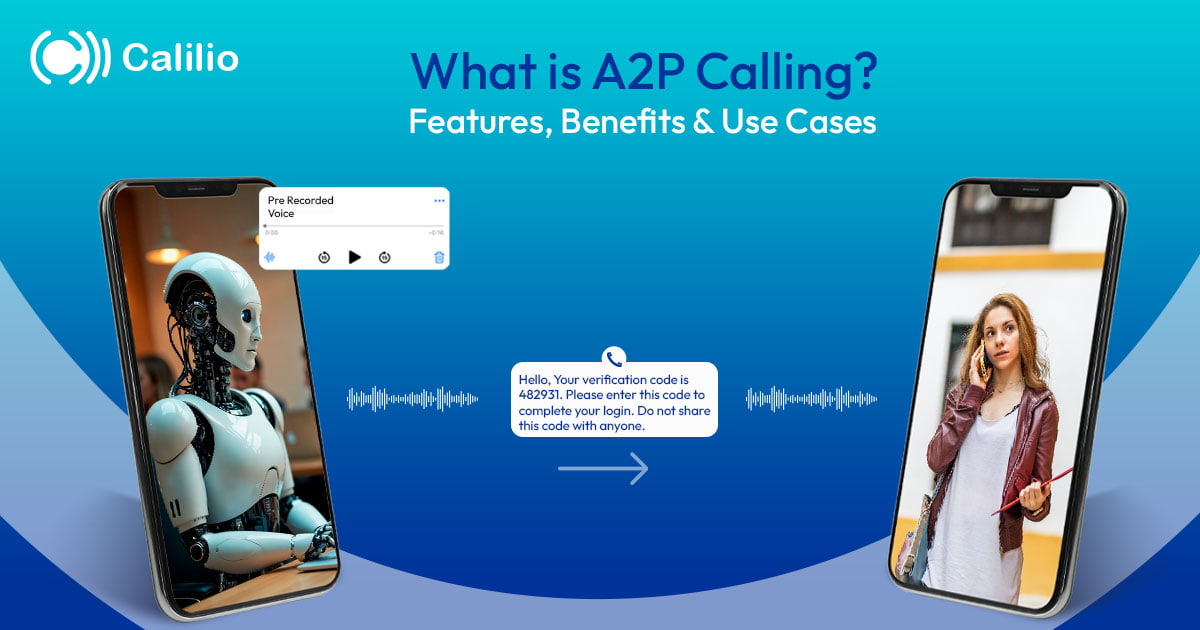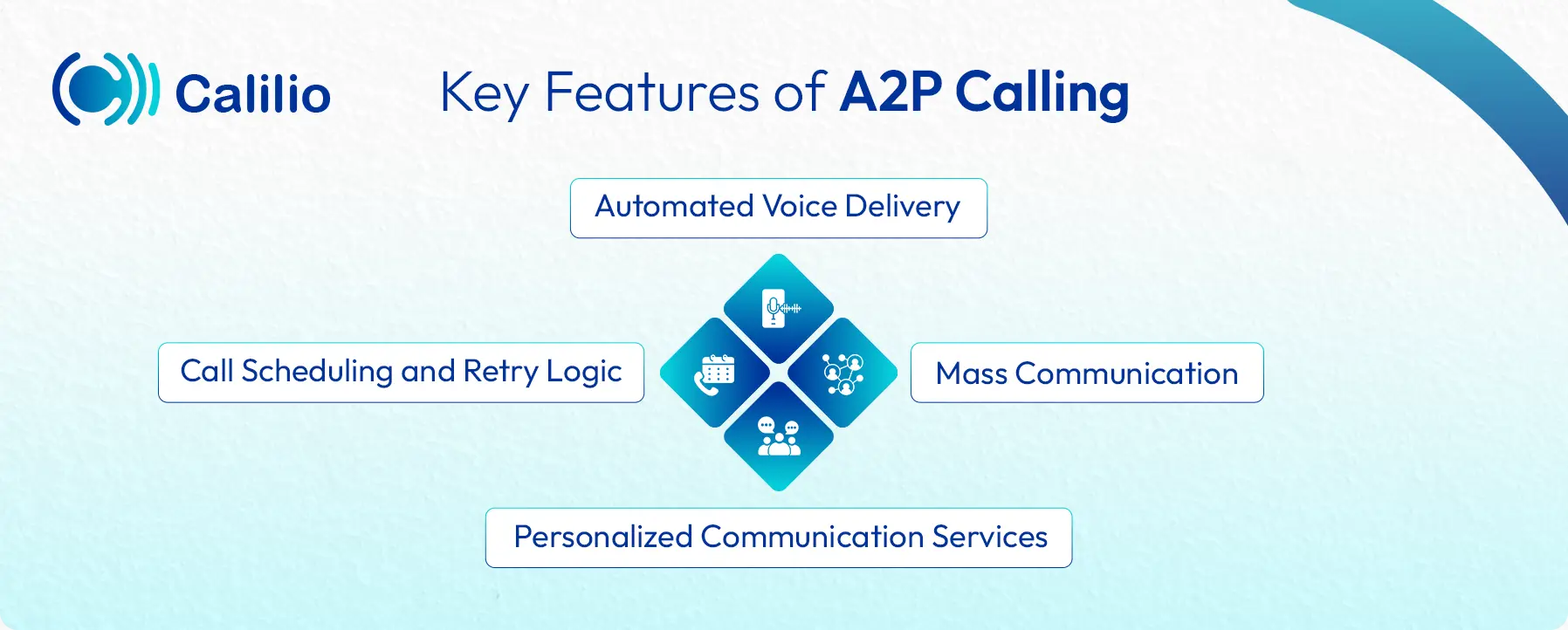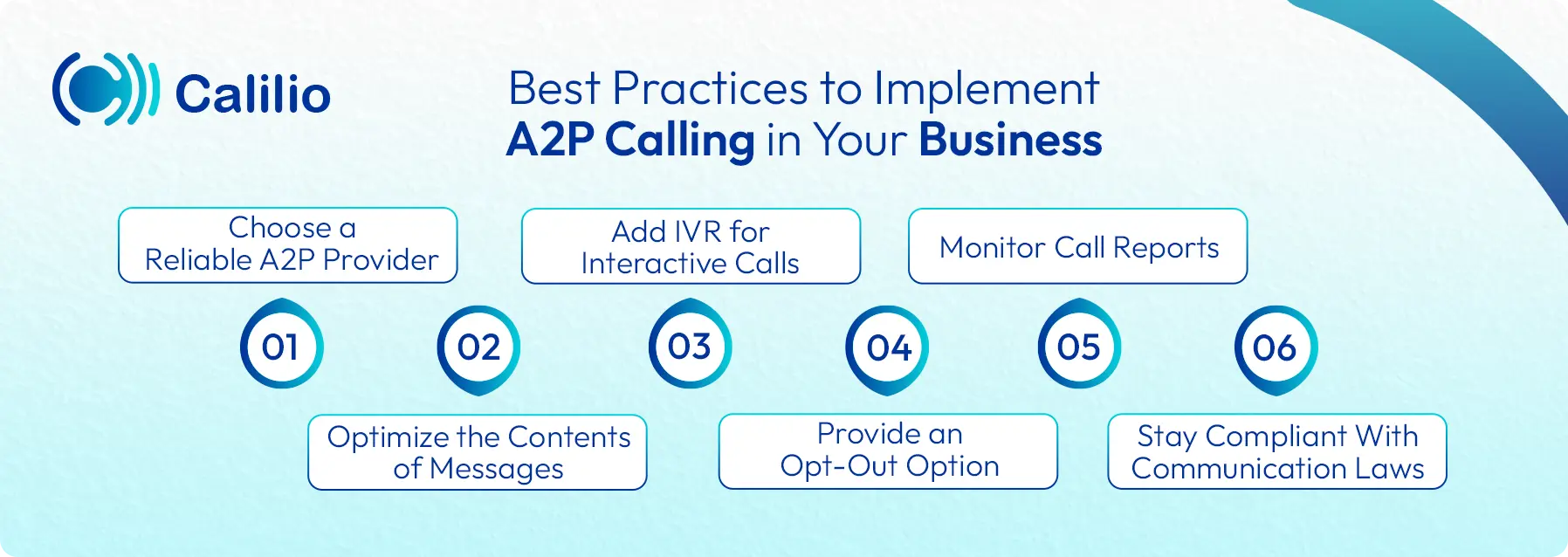What is A2P Calling? Benefits & Best Practices

Businesses send OTPs, appointment reminders, and account alerts every day via SMS. But at times, they go unnoticed as customers get many messages daily. It leads to communication delays and missed verifications, which can also affect your brand image.
That’s why many companies are adopting A2P calling. Instead of sending a text that might get lost in a pile of notifications, A2P (Application-to-Person) calling uses automated voice calls to deliver important updates. It ensures time-sensitive information reaches the right person, fast and clearly.
In this blog, you’ll learn what A2P calling is and how it works, alongside its key features, use cases, and benefits. Additionally, we’ll also share the tips to implement it effectively for your business.
Keep reading!
Key Highlights:
A2P calling is an automated voice communication system where applications send voice messages directly to users’ phones.
It helps businesses deliver OTPs, alerts, reminders, and marketing messages in real time, without manual effort.
A2P calls are typically one-way, but can become interactive when combined with IVR (Interactive Voice Response).
A2P calling system typically includes features like automated voice delivery, IVR integration, flash call support, call scheduling, and large-scale call handling.
When implementing A2P calling for a business, choose a reliable provider that offers you the ability to personalize messages, add IVR, track performance, and stay compliant with GDPR and TCPA.
What is A2P Calling?
A2P (Application-to-Person) calling is a type of automated calling system that allows businesses to send pre-recorded voice messages from an application directly to a user’s phone. Unlike regular calls made by a person, A2P calls are triggered by an automated system to deliver time-sensitive information, such as OTPs, reminders, alerts, and transaction updates.
A2P calls are typically one-way, intended solely to share information. However, when integrated with an IVR system, it can also allow customers to respond using their phone’s keypad or voice commands.
How Does A2P Calling Work?
A2P calling works by using software to automatically send voice messages from a business application to a person’s phone. The system records a message in advance, stores the user’s phone number, and then places a call to deliver the message at the right.
Here is how the process works step by step:
- Event Trigger: The system detects an event, such as a login request, order update, or appointment reminder.
- Message Generation: Based on the event, the system selects or creates a suitable voice message. This message can be pre-recorded audio or text converted into speech.
- Number Retrieval: The system retrieves the user’s phone number from the database.
- Call Initiation: The A2P platform then places a call to the recipient using cloud telephony, VoIP systems, or traditional PSTN.
- Voice Message Delivery: Once the recipient answers the call, the voice message plays automatically.
- Optional Interaction: If IVR is used, the user can respond using keypad inputs or voice commands.
Key Features of A2P Calling
A2P calling offers features like instant voice message delivery, flash call verification, mass communication, and personalized voice messages. These features can be updated and customized to meet a business's specific requirements on a timely basis.

1. Automated Voice Delivery
With A2P calling, businesses can use recorded voice messages to answer customer queries. These messages are delivered through automated calls, saving time and reducing the need for live agents.
2. Mass Communication
A2P platforms can send thousands of calls at once, making them ideal for handling a large volume of calls. It’s suitable for large campaigns, urgent alerts, or mass verifications. It reduces the need for manual dialing and ensures fast, consistent delivery without overloading your phone lines.
3. Personalized Communication Services
A2P calling lets you send automated voice messages that sound personal and relevant to each customer. You can record custom messages based on their needs, helping your business offer better and more targeted service.
4. Call Scheduling and Retry Logic
You can schedule A2P calls for specific times. If a call fails or goes unanswered, the system can call again later based on predefined rules.
What Are the Use Cases for A2P Calling?
Businesses use A2P calling to send voice-based OTPs, confirm user identity, share alerts, and gather customer feedback. Additionally, it’s also helpful in marketing campaigns and delivering important updates at any time.
Conducting Surveys and Gathering Feedback
After a service or product delivery, businesses send automated calls asking for feedback. Customers can respond by pressing keys or speaking their responses. This makes it easier to collect insights and improve services.
One-Time Password (OTP) Delivery
A2P calling is used to send OTPs instantly when users log in, make payments, or verify accounts. It ensures the message reaches them even if SMS fails. This helps protect user data and speed up verification.
2FA (Two-factor Authentication)
Businesses use A2P calls as an added layer of login security. After entering a password, users receive a voice call with a code to confirm their identity. This two-factor authentication process reduces the risk of unauthorized access.
Launching Strategic Marketing Campaigns
Businesses can use A2P voice calls to promote special offers, new products, or events. Compared to texts, voice adds a more personal and engaging touch. Additionally, it’s direct and more effective at creating a sense of urgency or excitement around a limited-time offer.
Notifications and Alerts
A2P calls can be used to quickly share updates like delivery delays, service changes, or policy updates. It helps businesses keep customers informed in real time.
How Do Businesses Benefit From A2P Calling?
A2P calling helps businesses deliver time-sensitive information instantly, improve customer engagement, and reach users around the clock. It also reduces operational costs, enhances service quality, and allows for strategic, large-scale voice-based outreach.
I. Delivery of Time-Sensitive Information
Calls are delivered instantly when triggered by a user action or system event. You can also set up these calls for mass communication. It ensures that time-sensitive messages, like OTPs, alerts, and targeted marketing campaigns, reach users without delay.
II. Strategic Outreach Coordination
A2P calling helps businesses reach the right customers at the right time. They can schedule calls based on seasons, promotions, or customer groups, and send A2P messages or voice messages in bulk within a set time frame.
For example: A streaming service can alert its customers to subscribe to their channel for a discounted price during the festive season.
III. Enhanced Engagement and Reliability
Unlike text messages, voice calls are harder to miss. When a call rings, users are more likely to respond immediately. This improves message visibility and ensures your communication reaches the customer directly.
IV. 24/7 Availability
A2P calling systems can be activated 24/7. They can send voice calls at any time of day or night, without depending on staff availability. This makes it easy to send reminders, alerts, or confirmations even outside of regular business hours.
V. Cost-Effective Communication
A2P calling automates the entire calling process, reducing the need for large support teams to handle routine communication. This saves both time and money while allowing teams to focus on other important tasks.
VI. Improved Customer Services
A2P voice calls deliver accurate information when clients need it most. This helps avoid confusion, reduces follow-ups, and fosters trust. Businesses can enhance customer satisfaction and create a more professional impression.
Best Practices to Implement A2P Calling in Your Business
To effectively implement A2P calling in your business, make sure that you choose a reliable service provider and focus on sending clear and personalized messages. Additionally, consider adding an IVR for interaction, offering an opt-out option, tracking call performance, and ensuring full compliance with laws such as GDPR and TCPA.

1. Choose a Reliable A2P Provider
Select a trusted A2P calling platform with high call success rates, global reach, and strong support. A reliable provider ensures your voice messages are delivered on time and without errors.
2. Optimize the Contents of Messages
Set intentional messages and convey information clearly and concisely. Similarly, avoid using jargon words and abbreviations, as they may confuse customers. Also, personalize messages to a specific group of customers to improve engagement.
3. Add IVR for Interactive Calls
If your message needs a response, include Interactive Voice Response (IVR). Let customers press keys or speak commands to confirm, cancel, or get more information.
4. Provide an Opt-Out Option
Give users a way to stop receiving promotional or non-critical calls. This shows respect for their preferences and helps you stay compliant with communication laws.
5. Monitor Call Reports
Track how many calls were answered, missed, or failed. Use these insights to improve timing, message quality, and targeting.
6. Stay Compliant With Communication Laws
Follow regional and international communication laws such as GDPR and TCPA. This includes getting proper consent and handling customer data responsibly.
Conclusion
A2P calling gives businesses a fast, reliable, and scalable way to communicate with customers through automated voice messages. From delivering OTPs and alerts to running campaigns and collecting feedback, it ensures that important information reaches the right person at the right time.
With features like mass calling, flash call support, and IVR integration, it enhances customer engagement while reducing manual work and operational costs. When implemented with the right strategy and compliance measures, A2P calling can improve service quality, boost trust, and support business growth.
Your Phone System Just Got Cheaper
Virtual numbers from just $2/month
Call rates starting as low as $0.016/min
The most cost-effective VoIP phone system for businesses
Powered by advanced AI telephony features
Compare low-cost business phone systems
Frequently Asked Questions
How is A2P calling different from P2P calling?
P2P (Person-to-Person) calls involve live conversation between two people, while A2P calling is automated voice calls initiated by applications for mass communication like OTPs, notifications, or alerts.
Can users respond to A2P calls?
How can I detect A2P calls
Is A2P calling secure and compliant?
Do I need to register for A2P 10DLC to send A2P voice calls?

Still have questions?
Can’t find the answer you’re looking for? Please chat with our friendly team.
Stay in the loop
Get the latest call insights, trends, and updates delivered straight to your inbox.
By subscribing, you agree to receive updates from Calilio.
You can unsubscribe anytime.
Phone numbers
Get International Phone Numbers
Singapore
|Australia
|New Zealand